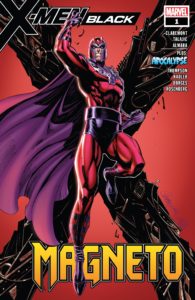 X-Men: Black — Magneto #1 (of 1) — Writer: Chris Claremont; Pencils: Dalibor Talajic; Inks: Roberto Poggi and Belarino Brabo; Colors: Dono Sanchez-Almara
X-Men: Black — Magneto #1 (of 1) — Writer: Chris Claremont; Pencils: Dalibor Talajic; Inks: Roberto Poggi and Belarino Brabo; Colors: Dono Sanchez-Almara
Superior Octopus #1 (of 1) — Writer: Christos Gage; Pencils: Mike Hawthorne; Inks: Wade von Grawbadger; Colors: Jordie Bellaire
Typhoid Fever: Spider-Man #1 (of 1) — Writer: Clay McLeod Chapman; Art: Stefano Landini; Colors: Rachelle Rosenberg
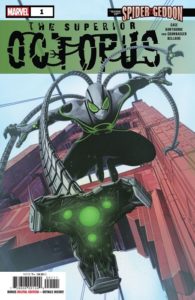 Sleepwalker #1 (of 4) — Writers: Chad Bowers and Chris Sims; Art: Todd Nauck; Colors: Rachelle Rosenberg
Sleepwalker #1 (of 4) — Writers: Chad Bowers and Chris Sims; Art: Todd Nauck; Colors: Rachelle Rosenberg
Shatterstar #1 (of 5) — Writer: Tim Seeley; Pencils: Carlos Villa and Gerardo Sandoval; Inks: Juan Vlasco; Colors: Carlos Lopez
X-Men: Black is a series of weekly one-shots spotlighting Marvel mutant sometime-villains; this week’s first issue has Magneto by long-time X-writer Chris Claremont, who was the first scripter to give the Master of Magnetism actual personality and a backstory. It’s good to see 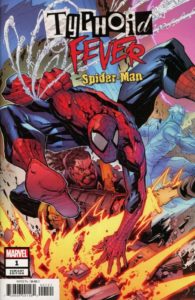 Claremont getting work, and his treatment of Magneto is character-rich and effective (although the art is only so-so); there’s also an Apocalypse back-up that will be continuing through all five issues of the series, by Zac Thompson, Lonnie Nadler, Geraldo Borges and Rachelle Rosenberg (and, if you’re wondering, the other four books will cover Mojo, Mystique, Juggernaut and Emma Frost). Superior Octopus is a one-shot showing what’s been up with Dr. Octavius since his resurrection and new sort-of-chaotic-good status; a back-up tale by Jed McCay, Mark Bagley, Craig Yeung and Dono Sanchez-Almara ties it all into the looming Spider-Gedden mini-series, and leads directly into its first issue next week, so if you’re getting
Claremont getting work, and his treatment of Magneto is character-rich and effective (although the art is only so-so); there’s also an Apocalypse back-up that will be continuing through all five issues of the series, by Zac Thompson, Lonnie Nadler, Geraldo Borges and Rachelle Rosenberg (and, if you’re wondering, the other four books will cover Mojo, Mystique, Juggernaut and Emma Frost). Superior Octopus is a one-shot showing what’s been up with Dr. Octavius since his resurrection and new sort-of-chaotic-good status; a back-up tale by Jed McCay, Mark Bagley, Craig Yeung and Dono Sanchez-Almara ties it all into the looming Spider-Gedden mini-series, and leads directly into its first issue next week, so if you’re getting 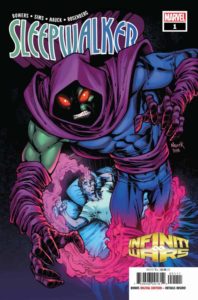 that you should get this too. Typhoid Fever: Spider-Man is a trilogy set up just like this summer’s Wakanda Forever story; it features the split-personality villain Typhoid Mary (whose skill set combines pyrokinesis (i.e., setting things on fire with her mind), telekinesis and mind control), and will continue into X-Men and Iron Fist one-shots (since she’s a Daredevil villain, you’d think he’d appear somewhere in there too…). Decent art and an intriguingly powerful (and psychotic) adversary make this interesting enough to try. Sleepwalker is a tie-in to Infinity Wars, with that now-obscure ’90s alien (although he had his own book for a while…) taking four issues to deal with the now-folded-in-half, character-combined Marvel universe; solid art by the reliable Todd Nauck helps, and, as
that you should get this too. Typhoid Fever: Spider-Man is a trilogy set up just like this summer’s Wakanda Forever story; it features the split-personality villain Typhoid Mary (whose skill set combines pyrokinesis (i.e., setting things on fire with her mind), telekinesis and mind control), and will continue into X-Men and Iron Fist one-shots (since she’s a Daredevil villain, you’d think he’d appear somewhere in there too…). Decent art and an intriguingly powerful (and psychotic) adversary make this interesting enough to try. Sleepwalker is a tie-in to Infinity Wars, with that now-obscure ’90s alien (although he had his own book for a while…) taking four issues to deal with the now-folded-in-half, character-combined Marvel universe; solid art by the reliable Todd Nauck helps, and, as 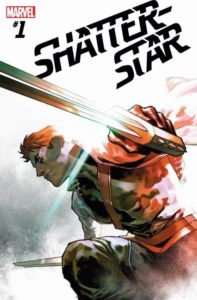 with the other “warped” comics this month, seeing all the hero and villain combos (like “Scott Banner,” who turns into an ant-size Hulk when he gets mad) offers some fun. Shatterstar is a five-issue mini-series spotlighting that former Mojoworld gladiator and X-Force member; it opens with him as a landlord of an apartment house in Queens, which sounds boringly normal until we find that the apartment only rents to stranded other-dimensional or other-timeline refugees, to help them adjust to Earth life. That useful and happy existence, of course, gets screwed up by old foes within just a couple of pages; the decent set-up by writer Tim Seeley and OK art from Carlos Villa and Gerardo Sandoval combine to make it worth a look.
with the other “warped” comics this month, seeing all the hero and villain combos (like “Scott Banner,” who turns into an ant-size Hulk when he gets mad) offers some fun. Shatterstar is a five-issue mini-series spotlighting that former Mojoworld gladiator and X-Force member; it opens with him as a landlord of an apartment house in Queens, which sounds boringly normal until we find that the apartment only rents to stranded other-dimensional or other-timeline refugees, to help them adjust to Earth life. That useful and happy existence, of course, gets screwed up by old foes within just a couple of pages; the decent set-up by writer Tim Seeley and OK art from Carlos Villa and Gerardo Sandoval combine to make it worth a look.
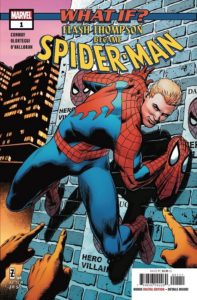 What If? Spider-Man #1 (of 1) — Writer: Gerry Conway; Art: Diego Olortegui; Ink Assists: Walden Wong; Colors: Chris O’Halloran
What If? Spider-Man #1 (of 1) — Writer: Gerry Conway; Art: Diego Olortegui; Ink Assists: Walden Wong; Colors: Chris O’Halloran
What If? X-Men #1 (of 1) — Writer: Bryan Edward Hill; Art: Neil Edwards and Giannis Milonogiannis; Colors: Rachelle Rosenberg
True Believers: What If The Avengers Had Fought Evil During the 1950s? #1 (of 1) — Writer: Don Glut; Art: Alan Kupperberg and Bill Black; Colors: Carl Gafford
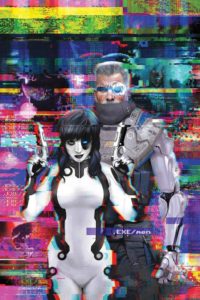 True Believers: What If Jane Foster Had Found the Hammer of Thor? #1 (of 1) — Writer: Don Glut; Pencils: Rich Hoberg; Inks: Dave Hunt; Colors: Carl Gafford
True Believers: What If Jane Foster Had Found the Hammer of Thor? #1 (of 1) — Writer: Don Glut; Pencils: Rich Hoberg; Inks: Dave Hunt; Colors: Carl Gafford
Once every few years, Marvel releases a clutch of What If? alternate-reality stories (partly to retain legal rights to the title), and this October they’re arriving again: What If Flash Thompson Became Spider-Man is a classic change-one-item scenario, of course involving Flash getting bit by that radioactive spider instead of Peter; it’s by long-time comics writer Gerry Conway (“long” as in his first work  was published almost 50 years ago), and could easily have appeared in the original What If? run. On the other hand, What If? X-Men is more of an alternate-universe DC-Elseworlds deal, wherein the X-Men aren’t mutants in the real world, but users of cyberspace who have an “exe gene” that lets them bypass security protocols and other restrictions; this tale involves versions of Professor X, Magneto, Domino and Cable, although the other X-people get a little time too; as always with this kind of story, most of the fun is in seeing familiar characters in unfamiliar circumstances and relationships, and spotting all of the
was published almost 50 years ago), and could easily have appeared in the original What If? run. On the other hand, What If? X-Men is more of an alternate-universe DC-Elseworlds deal, wherein the X-Men aren’t mutants in the real world, but users of cyberspace who have an “exe gene” that lets them bypass security protocols and other restrictions; this tale involves versions of Professor X, Magneto, Domino and Cable, although the other X-people get a little time too; as always with this kind of story, most of the fun is in seeing familiar characters in unfamiliar circumstances and relationships, and spotting all of the 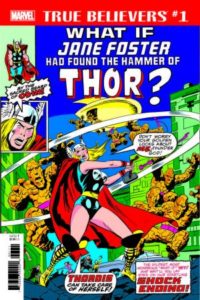 differences. Two of Marvel’s True Believer” $1 reprints tie in, too — they reprint issues #9 and 10 of the original ’70s What If? series. Issue #10’s reprint makes sense — its decades-old “What if Jane Foster Became Thor?” conceit became hot when, a couple of years ago, she did become Thor, and now costs $65 — but it’s not clear why they picked issue #9’s Avengers tale; replacing the “real” ’60s Avengers mainstays with 1950s characters — some actually from Marvel ’50s comics, and others retconned in — is fun enough, but you can probably find readable copies of the original in our Discount Hub for 99 cents, so the $1 price point for the reprint isn’t much incentive….
differences. Two of Marvel’s True Believer” $1 reprints tie in, too — they reprint issues #9 and 10 of the original ’70s What If? series. Issue #10’s reprint makes sense — its decades-old “What if Jane Foster Became Thor?” conceit became hot when, a couple of years ago, she did become Thor, and now costs $65 — but it’s not clear why they picked issue #9’s Avengers tale; replacing the “real” ’60s Avengers mainstays with 1950s characters — some actually from Marvel ’50s comics, and others retconned in — is fun enough, but you can probably find readable copies of the original in our Discount Hub for 99 cents, so the $1 price point for the reprint isn’t much incentive….
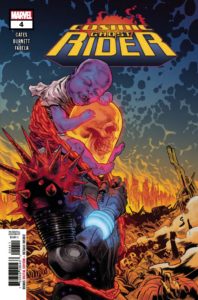 Cosmic Ghost Rider #4 — Writer: Donny Cates; Art: Dylan Burnett; Colors: Antonio Fabela
Cosmic Ghost Rider #4 — Writer: Donny Cates; Art: Dylan Burnett; Colors: Antonio Fabela
Death of the Inhumans #4 (of 5) — Writer: Donny Cates; Art: Ariel Olivetti; Colors: Jordie Bellaire
Iron Man #4 (Legacy #604) — Writer: Dan Slott; Art: Valerio Schiti; Colors: Edgar Delgado
Doctor Strange #6 (Legacy #396) — Writer: Mark Waid; 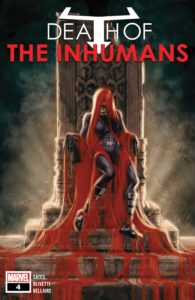 Art: Javier Pina; Colors: Brian Reber
Art: Javier Pina; Colors: Brian Reber
Cosmic Ghost Rider‘s gonzo, anything-goes plot involves a far-future Frank Castle who’s become, yes, a cosmic Ghost Rider, but he’s traveled back to our time to kidnap the baby Thanos and try to raise it on his own (nature vs. nurture), only to have a young-adult Thanos show up, too… are they going to have a polite philosophical discussion, or a big fight? Writer Donny Cates plays it all straight, and lets the ridiculousness 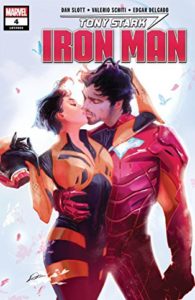 come through around the edges, and the B-movie energy of it all somehow carries it along and makes it work. So too for his Death of the Inhumans, which in its penultimate chapter makes good use of the comics trope that, if you haven’t actually seen a body, they aren’t really dead — but in a clever way that ends up revealing a very different villain than we thought. Iron Man sees a romance developing between old flames Janet van Dyne and Tony, along with a dating app that lots of Stark Unlimited employees are using that leads to (a) a
come through around the edges, and the B-movie energy of it all somehow carries it along and makes it work. So too for his Death of the Inhumans, which in its penultimate chapter makes good use of the comics trope that, if you haven’t actually seen a body, they aren’t really dead — but in a clever way that ends up revealing a very different villain than we thought. Iron Man sees a romance developing between old flames Janet van Dyne and Tony, along with a dating app that lots of Stark Unlimited employees are using that leads to (a) a 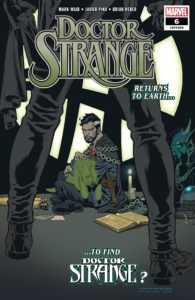 security breach, and (b) a long discussion about the rights of sentient machines/A.I.; Dan Slott’s putting an engaging, well-thought-out high-tech shine on this book so far, and Valerio Schiti’s art is up to making the large cast, and all the action, clear and attractive. Doctor Strange begins a new arc (one that will lead up to its 400th issue) with Doc coming back from space with a new associate, but finding a doppleganger Doc already there; the solution to the mystery involves writer Mark Waid’s previous Strange mini-series from 2010, and offers the usual smart storytelling along with showcasing Strange’s recent magical power-ups.
security breach, and (b) a long discussion about the rights of sentient machines/A.I.; Dan Slott’s putting an engaging, well-thought-out high-tech shine on this book so far, and Valerio Schiti’s art is up to making the large cast, and all the action, clear and attractive. Doctor Strange begins a new arc (one that will lead up to its 400th issue) with Doc coming back from space with a new associate, but finding a doppleganger Doc already there; the solution to the mystery involves writer Mark Waid’s previous Strange mini-series from 2010, and offers the usual smart storytelling along with showcasing Strange’s recent magical power-ups.
Wonder Woman and Justice League Dark: The Witching Hour #1 (of 1) — Writer: James Tynion IV; Art: Jesus Merino; Colors: Romulo Fajardo
Nightwing #50 — Writer: Benjamin Percy; Art: Travis Moore, Chris Mooneyham and Klaus Janson; Colors: Tamra Bonvillain, Nick Filardi and John Kalisz
Batman #56 — Writer: Tom King; Pencils: Tony S. Daniels; Inks: Daniels and Danny Miki; Colors: Tomeu Moray
 Batman/The Maxx: Arkham Dreams #1 (of 5) — Writer/Artist: Sam Kieth; Colors: Ronda Pattison
Batman/The Maxx: Arkham Dreams #1 (of 5) — Writer/Artist: Sam Kieth; Colors: Ronda Pattison
The Dreaming #2 — Writer: Simon Spurrier; Art: Bilquis Evely; Colors: Mat Lopes
United States Vs. Murder Inc. #2 — Writer: Brian Michael Bendis; Art: Michael Avon Oeming; Colors: Taki Soma
Witching Hour is a five-part weekly series that will conclude, naturally, on Hallowe’en; it involves this week’s 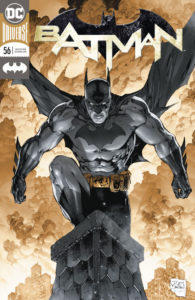 Wonder Woman and Justice League Dark, then will continue in next week’s regular Wonder Woman, then Justice League Dark, then Wonder Woman again, and finally conclude with a Justice League Dark and Wonder Woman bookend. Obviously, witchcraft is involved, specifically the goddess Hecate, although events tie into the otherworldly horrors being battled in the regular JLDark book, too. It’s satisfyingly spooky enough, with a couple of chilling demonstrations of Hecate’s power; Jesus Merino has a thin, detailed line that’s good at delineating both the regular characters and the occult nastiness. Meanwhile,
Wonder Woman and Justice League Dark, then will continue in next week’s regular Wonder Woman, then Justice League Dark, then Wonder Woman again, and finally conclude with a Justice League Dark and Wonder Woman bookend. Obviously, witchcraft is involved, specifically the goddess Hecate, although events tie into the otherworldly horrors being battled in the regular JLDark book, too. It’s satisfyingly spooky enough, with a couple of chilling demonstrations of Hecate’s power; Jesus Merino has a thin, detailed line that’s good at delineating both the regular characters and the occult nastiness. Meanwhile,  the Bat-books are dealing with major grim events involving Nightwing (as in, he got shot in the head by a sniper in last month’s Batman #55), and Nightwing #50 shows that it erased a big chunk of his memory, including all of the costumed-adventurer stuff; he’s not quite a blank slate, but he’s now unburdened by his involved previous history. These screwing-with-a-character events usually work well for the first couple of issues, with a fresh new direction, and then trail off as everyone gets bored and waits for the inevitable return to the default setting; let’s hope DC has a clever plan to avoid that. Batman #56 has Batman tracking down the sniper, who’s an old adversary; Tom King and Tony S. Daniels don’t seem to have any trouble
the Bat-books are dealing with major grim events involving Nightwing (as in, he got shot in the head by a sniper in last month’s Batman #55), and Nightwing #50 shows that it erased a big chunk of his memory, including all of the costumed-adventurer stuff; he’s not quite a blank slate, but he’s now unburdened by his involved previous history. These screwing-with-a-character events usually work well for the first couple of issues, with a fresh new direction, and then trail off as everyone gets bored and waits for the inevitable return to the default setting; let’s hope DC has a clever plan to avoid that. Batman #56 has Batman tracking down the sniper, who’s an old adversary; Tom King and Tony S. Daniels don’t seem to have any trouble 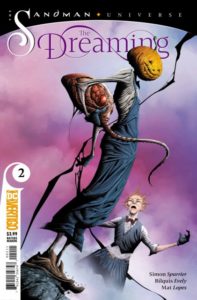 maintaining its status as DC’s top-selling regular comic. Sam Kieth, like Kelley Jones, is an old-time artist often associated with Batman; every couple of years, he puts out a mini-series about him, and it’s always quirky and fun and pretty to look at. This time out, he’s guest-starring his own breakout creation, the Maxx, and setting it in Arkham; that should be enough to get readers, especially of a certain age, to buy it. The Dreaming continues to not be about Dream, who’s missing, but about all the other characters of his realm, especially the archetypal handyman Merv Pumpkinhead, as things go to hell without the Dreaming’s leader. Simon Spurrier tends to
maintaining its status as DC’s top-selling regular comic. Sam Kieth, like Kelley Jones, is an old-time artist often associated with Batman; every couple of years, he puts out a mini-series about him, and it’s always quirky and fun and pretty to look at. This time out, he’s guest-starring his own breakout creation, the Maxx, and setting it in Arkham; that should be enough to get readers, especially of a certain age, to buy it. The Dreaming continues to not be about Dream, who’s missing, but about all the other characters of his realm, especially the archetypal handyman Merv Pumpkinhead, as things go to hell without the Dreaming’s leader. Simon Spurrier tends to  plot in six- and twelve-issue chunks, so let’s hope this doesn’t go on too long, but at this second-issue stage it’s enough to watch Bilquis Evely’s obvious enjoyment at getting to draw a guy with a pumpkin for a head (and smoking a cigar) for four or five dozen panels. It wouldn’t be a DC week lately without a Brian Bendis book, and this week’s is his and Michael Avon Oemings’s hard-boiled alternate-history Mafia comic United States Vs. Murder Inc. It concludes a backstory for Jagger Rose, hit-woman and now partner to the hero; Oemings’s jagged panel layouts and Taki Soma’s lurid, color-soaked palette make it feel like some weird late-’40s film-noir crime comic written by Mario Puzo.
plot in six- and twelve-issue chunks, so let’s hope this doesn’t go on too long, but at this second-issue stage it’s enough to watch Bilquis Evely’s obvious enjoyment at getting to draw a guy with a pumpkin for a head (and smoking a cigar) for four or five dozen panels. It wouldn’t be a DC week lately without a Brian Bendis book, and this week’s is his and Michael Avon Oemings’s hard-boiled alternate-history Mafia comic United States Vs. Murder Inc. It concludes a backstory for Jagger Rose, hit-woman and now partner to the hero; Oemings’s jagged panel layouts and Taki Soma’s lurid, color-soaked palette make it feel like some weird late-’40s film-noir crime comic written by Mario Puzo.
 The Umbrella Academy: Hotel Oblivion #1 (0f 7) — Writer: Gerard Way; Art: Gabriel Ba; Colors: Nick Filardi
The Umbrella Academy: Hotel Oblivion #1 (0f 7) — Writer: Gerard Way; Art: Gabriel Ba; Colors: Nick Filardi
Jook Joint #1 (of 5) — Writer: Tee Franklin; Art: Alitha E. Martinez; Colors: Shari Chankhamma
Errand Boys #1 (of 5) — Writer: D. J. Kirkbride; Art/Colors: Nikos Koutsis
Dead Rabbit #1 — Writer: Gerry Duggan; Art: John McRea; Colors: Mike Spicer
Sparrowhawk #1 (of 5) — Writer: Delilah S. Dawson; Art/Colors: Matias Basla
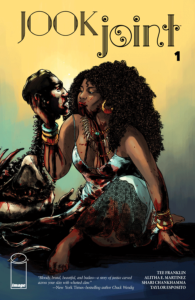 Blackbird #1 — Writer: Sam Humphries; Art: Jen Bartel; Layouts: Paul Reinwand; Colors: Bartel and Nayoung Wilson
Blackbird #1 — Writer: Sam Humphries; Art: Jen Bartel; Layouts: Paul Reinwand; Colors: Bartel and Nayoung Wilson
Ten years ago, back before Gerard Way was running DC’s “Young Animals” imprint — and while he was still fronting the rock group My Chemical Romance — he and Brazilian wonder artist Gabriel Ba were creating The Umbrella Academy, about a group of kids raised to be superheroes by a Professor X-like mentor, and what happened when they all grew up and became disillusioned. It was a clever, complicated and sometimes deliberately-obscure comic (if you’ve been reading Way’s current Doom Patrol, you have some idea of its style), with beautiful every-line-in-place art 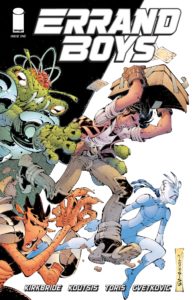 by Ba — and now it’s back. This sequel pretty much picks up where the last series left off; there’s no recap or explanation for new readers (although the individual scenes are intriguing and well-crafted enough to draw them in anyway), but for previous fans it’s like checking in with old friends after a too-long absence; there’s a lot of catching up to do, but you’re glad to see them again. Jook Joint is about a brothel in 1950s New Orleans run by voodoo/vampire women, who take any clients who abuse or disrespect the sex workers (or their wives or girlfriends) and exact bloody vengeance on them. It’s a feminist revenge fantasy; Tee Franklin, the author, talks in the editorial material about being a victim of abusive relationships, and writing it as therapy. What saves it are the sympathetic
by Ba — and now it’s back. This sequel pretty much picks up where the last series left off; there’s no recap or explanation for new readers (although the individual scenes are intriguing and well-crafted enough to draw them in anyway), but for previous fans it’s like checking in with old friends after a too-long absence; there’s a lot of catching up to do, but you’re glad to see them again. Jook Joint is about a brothel in 1950s New Orleans run by voodoo/vampire women, who take any clients who abuse or disrespect the sex workers (or their wives or girlfriends) and exact bloody vengeance on them. It’s a feminist revenge fantasy; Tee Franklin, the author, talks in the editorial material about being a victim of abusive relationships, and writing it as therapy. What saves it are the sympathetic 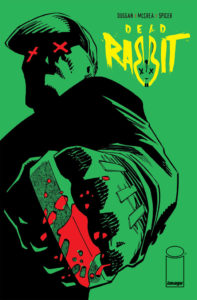 portraits and characterization of the women, especially Mahalia, the proprietor, and the art by Alitha E. Martinez, who has something of Gene Colan’s knack for rendering both the people and the horror effectively. Errand Boys is an sf book about a rogue who procures unusual items for clients — mostly by illegal means — and what happens when he has to take in his naive, orphaned teenage half-brother as a partner; think Hans Solo meeting a 13-year-old Luke Skywalker, taking him under his wing then, and traveling to various planets to steal stuff. This first issue does a good job of setting up the situation and characters, but, since books like this live or die based on the quality of their cons and capers, it’ll take another couple of episodes to determine its quality. Dead Rabbit is about a former
portraits and characterization of the women, especially Mahalia, the proprietor, and the art by Alitha E. Martinez, who has something of Gene Colan’s knack for rendering both the people and the horror effectively. Errand Boys is an sf book about a rogue who procures unusual items for clients — mostly by illegal means — and what happens when he has to take in his naive, orphaned teenage half-brother as a partner; think Hans Solo meeting a 13-year-old Luke Skywalker, taking him under his wing then, and traveling to various planets to steal stuff. This first issue does a good job of setting up the situation and characters, but, since books like this live or die based on the quality of their cons and capers, it’ll take another couple of episodes to determine its quality. Dead Rabbit is about a former  masked criminal who, years ago, had one last big score and retired — but now the money’s running out, his wife needs medical care, and he’s reluctantly getting drawn back into the game. Duggan, who’s written a lot of Deadpool comics, knows the morally-conflicted merc territory well, and John McRea’s art is worth a look — his work here is more polished and less caricaturey than, say, his Garth Ennis collaborations like Hitman and The Boys; I swear a couple of his panels reminded me of Joe Kubert. Sparrowhawk and Blackbird are both coming-of-age fantasy stories with young female protagonists; Sparrowhawk is about an American mulatto girl in 1850s British society who ends up getting kidnapped into a faerie dimension, and has to figure out how to survive and get back home; it reminded me of
masked criminal who, years ago, had one last big score and retired — but now the money’s running out, his wife needs medical care, and he’s reluctantly getting drawn back into the game. Duggan, who’s written a lot of Deadpool comics, knows the morally-conflicted merc territory well, and John McRea’s art is worth a look — his work here is more polished and less caricaturey than, say, his Garth Ennis collaborations like Hitman and The Boys; I swear a couple of his panels reminded me of Joe Kubert. Sparrowhawk and Blackbird are both coming-of-age fantasy stories with young female protagonists; Sparrowhawk is about an American mulatto girl in 1850s British society who ends up getting kidnapped into a faerie dimension, and has to figure out how to survive and get back home; it reminded me of 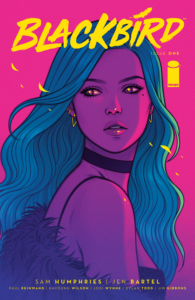 Mike Carey’s ’90s Books of Magic, with its easy grasp of the often-menacing otherworldly denizens, its fascinating, and sometimes flawed, main character, and its accomplished fantasy art. Blackbird‘s girl encountered wild magic at the age of 13, but only once, and nobody believed her; now, at 23, she’s unmoored and self-medicating — and, of course, the magic comes back…. Humphries, who’s done mainstream superhero stuff (Uncanny X-Force; Star-Lord) and indy books too, does a good job of character-building, while Jen Bartel’s art is simple and clear, and manages some nice effects on a couple of the magical splashes; like most of the first issues here, it’s an encouraging start, and raises hopes for a good series.
Mike Carey’s ’90s Books of Magic, with its easy grasp of the often-menacing otherworldly denizens, its fascinating, and sometimes flawed, main character, and its accomplished fantasy art. Blackbird‘s girl encountered wild magic at the age of 13, but only once, and nobody believed her; now, at 23, she’s unmoored and self-medicating — and, of course, the magic comes back…. Humphries, who’s done mainstream superhero stuff (Uncanny X-Force; Star-Lord) and indy books too, does a good job of character-building, while Jen Bartel’s art is simple and clear, and manages some nice effects on a couple of the magical splashes; like most of the first issues here, it’s an encouraging start, and raises hopes for a good series.
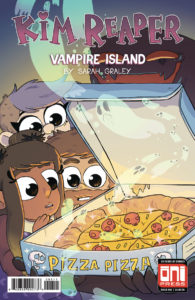 Kim Reaper: Vampire Island #2 (of 4) — Creator: Sarah Graley
Kim Reaper: Vampire Island #2 (of 4) — Creator: Sarah Graley
Warbears #2 (of 3) — Story: Margaret Atwood and Ken Steacy; Art: Ken Steacy
A Walk Through Hell #5 — Writer: Garth Ennis; Art: Goran Sudzuka; Colors: Ive Svorcina
Archie #699 — Writers: Mark Waid and Ian Flynn; Art/Colors: Various
Kim Reaper is about two college student, Becca and Kim;  Kim is an apprentice Grim Reaper, harvesting the souls of the dead, although for her it’s a part-time job, like delivering pizza but with teleportation and a scythe. Becca, who has no connection to the supernatural, finds out about all this as they become friends and then develop something of a romantic relationship; they go on adventures and hi-jinx ensue. This isn’t a comic with deep themes or actual horror, despite the occult parts — it’s a humor comic, a one-person production by Sarah Graley, and it’s both unassuming and entertaining. Warbears is a mini-series based on the Canadian comics companies who, while American comics
Kim is an apprentice Grim Reaper, harvesting the souls of the dead, although for her it’s a part-time job, like delivering pizza but with teleportation and a scythe. Becca, who has no connection to the supernatural, finds out about all this as they become friends and then develop something of a romantic relationship; they go on adventures and hi-jinx ensue. This isn’t a comic with deep themes or actual horror, despite the occult parts — it’s a humor comic, a one-person production by Sarah Graley, and it’s both unassuming and entertaining. Warbears is a mini-series based on the Canadian comics companies who, while American comics  were being embargoed during WWII, filled their absence with home-grown Canadian heroes; the story toggles between a nebbish artist and his family and office mates, and his comic, about a were-bear woman who, of course, fights the Nazis. It’s mostly a Ken Steacy production, although Canadian sf/feminist writer Margaret Atwood (Handmaid’s Tale) came up with the idea and collaborated on the story, and the combination of the mostly-sad real-life parts and the boisterous, optimistic superhero comic gives it an effective buzz. A Walk Through Hell is Garth Ennis horror, about FBI agents who’ve entered a warehouse
were being embargoed during WWII, filled their absence with home-grown Canadian heroes; the story toggles between a nebbish artist and his family and office mates, and his comic, about a were-bear woman who, of course, fights the Nazis. It’s mostly a Ken Steacy production, although Canadian sf/feminist writer Margaret Atwood (Handmaid’s Tale) came up with the idea and collaborated on the story, and the combination of the mostly-sad real-life parts and the boisterous, optimistic superhero comic gives it an effective buzz. A Walk Through Hell is Garth Ennis horror, about FBI agents who’ve entered a warehouse 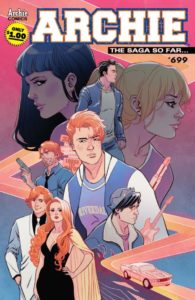 that somehow is also a portal to hell. This issue looks at one of the supporting-cast agents, as he becomes trapped by a nightmarish herd of small-but-terrifying monsters; because it’s Ennis, it’s memorably creepy and chilling, even without any overt violence or blood. Finally, Archie is approaching its 700th issue, so instead of its regular relaunch numbering, which would be #33, this week’s comic is #699; it’s a recap of those first 32 issues of the current run, all by Mark Waid, so if you’ve missed any of them, or just want to see what’s been going on with the Riverdale redhead and his friends, it’s a good way to get caught up — and even has a short preview of the upcoming #700, too.
that somehow is also a portal to hell. This issue looks at one of the supporting-cast agents, as he becomes trapped by a nightmarish herd of small-but-terrifying monsters; because it’s Ennis, it’s memorably creepy and chilling, even without any overt violence or blood. Finally, Archie is approaching its 700th issue, so instead of its regular relaunch numbering, which would be #33, this week’s comic is #699; it’s a recap of those first 32 issues of the current run, all by Mark Waid, so if you’ve missed any of them, or just want to see what’s been going on with the Riverdale redhead and his friends, it’s a good way to get caught up — and even has a short preview of the upcoming #700, too.




